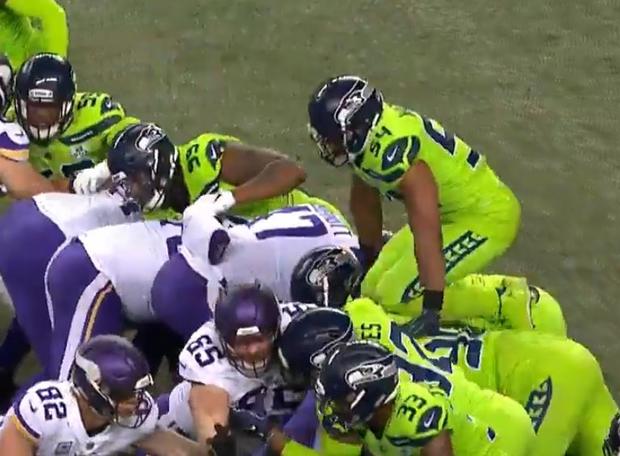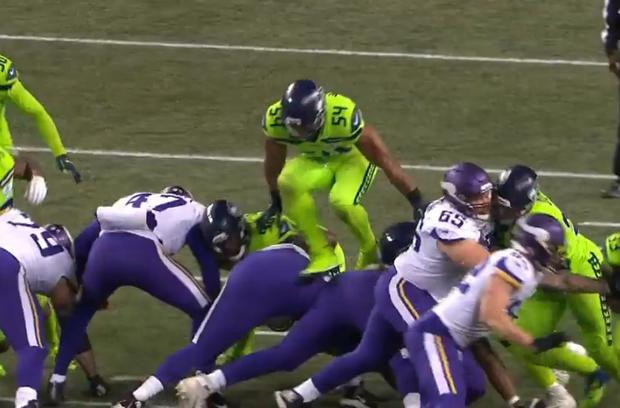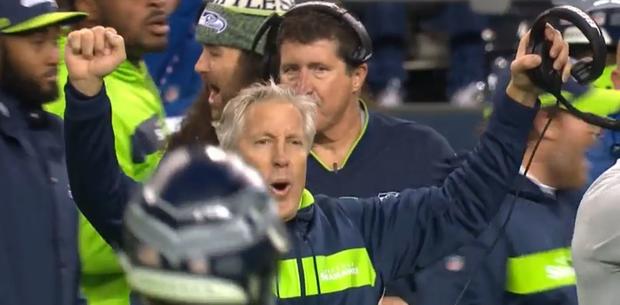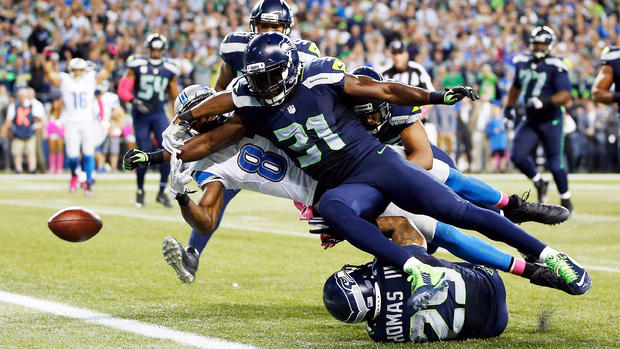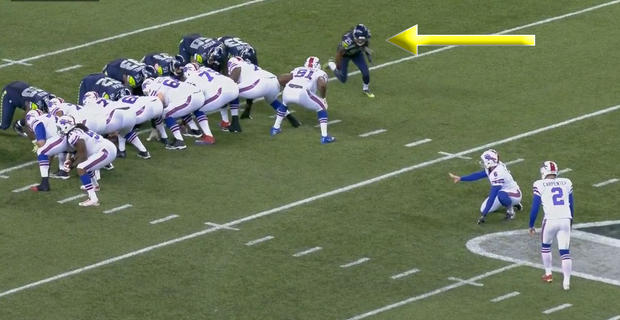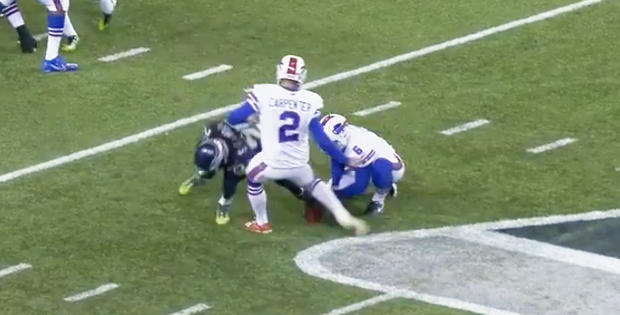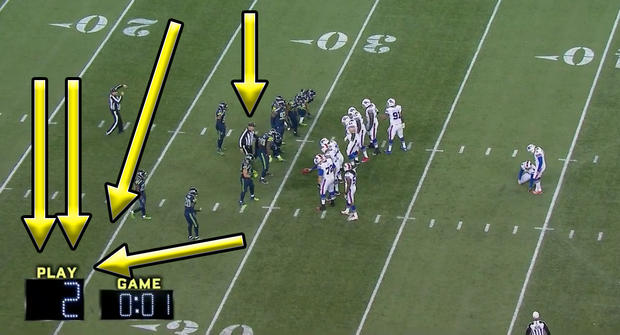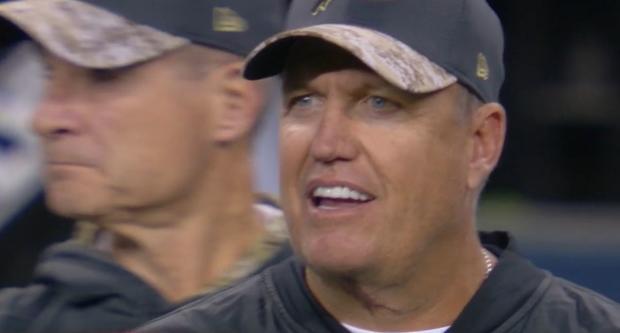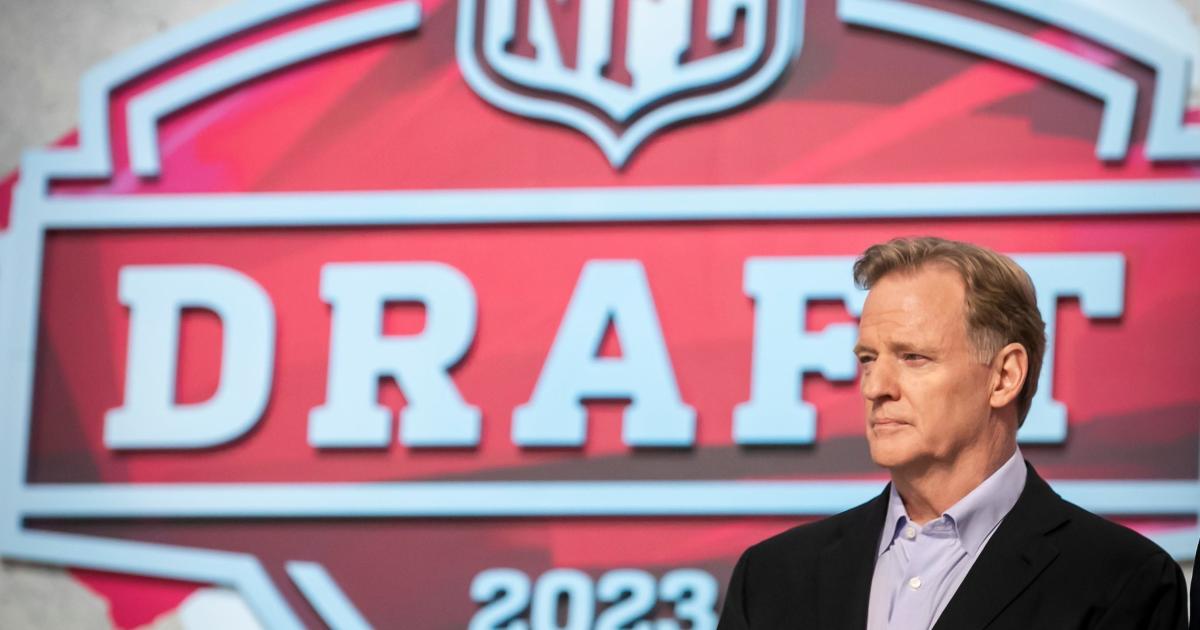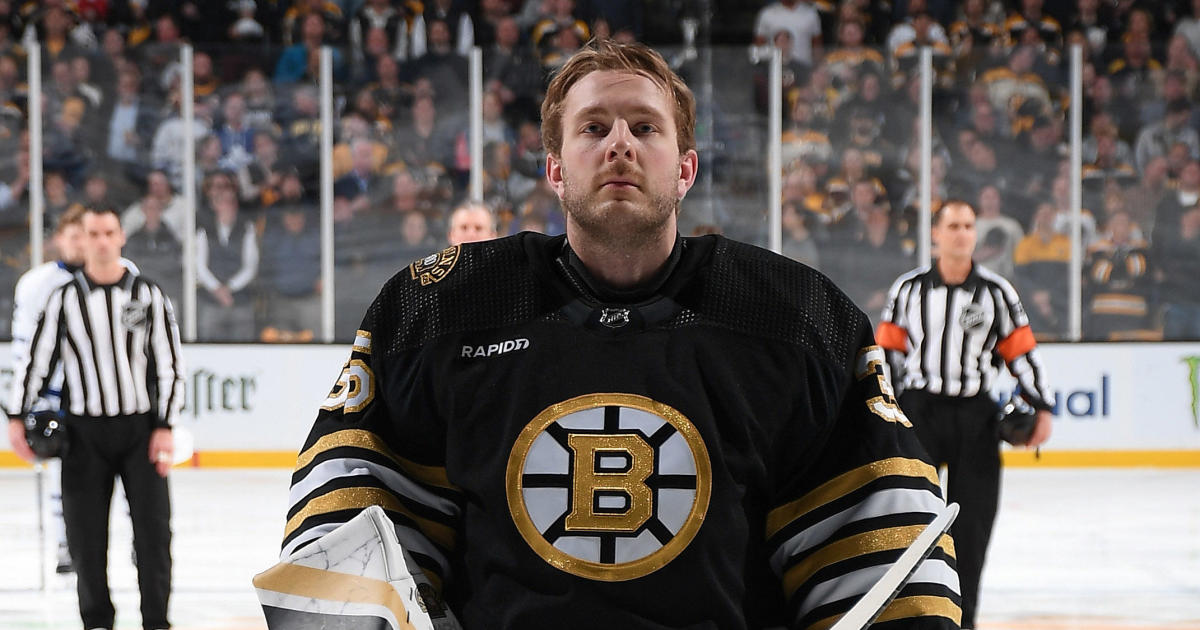Missed Penalty On Bobby Wagner Just The Latest Botch Job For NFL Referees In Seattle On Monday Night Football
By Michael Hurley, CBS Boston
BOSTON (CBS) -- There's just something about those bright Monday night lights and the crisp Pacific Northwest air that makes NFL referees and officials go a bit batty. After an officiating crew inexplicably blew yet another important call in Seattle on Monday night, what other conclusion can be made?
It's becoming quite the odd trend in recent years.
In this instance, the play in question involved Seahawks linebacker Bobby Wagner leaping over the line of scrimmage on a field goal attempt by Vikings kicker Dan Bailey. As we've learned in recent weeks, the 2017 offseason reporting of the NFL banning leaps over the line was inaccurate, as the NFL didn't outright ban the leaps but did ban players from getting running starts before attempting their leaps.
So, had Wagner cleanly made a leap over the line, it would have been legal. However, Wagner clearly put his hands down on teammates' shoulder pads in order to spring himself over the line of scrimmage before he blocked the kick.
This is a penalty. As the rulebook states clearly, this is illegal:
Placing a hand or hands on a teammate or opponent to gain additional height to block or attempt to block an opponent's kick or apparent kick, or in an attempt to jump through a gap to block an opponent's kick or apparent kick
As such, an official on the field -- umpire Ruben Fowler -- threw a penalty flag. Because, again, this is a penalty. Had the penalty been enforced, the Vikings would have gotten another chance to kick the field goal, this time from the Seattle 24-yard line, to cut Seattle's lead to 6-3.
But instead, inexplicably, referee Brad Allen announced to the Seattle crowd that, in fact, there was no penalty. That decision came after a chat between Foster and side judge Eugene Hall. Despite the infraction being clear as day, Hall seemed to have overruled Fowler, as Hall gave the final word to Allen.
"There is no foul on the play," Allen declared to the home crowd. "The runner was on the line of scrimmage and jumped legally over. Therefore, the result of the play is a first down, Seattle."
Seahawks head coach Pete Carroll responded thusly:
The Seahawks then drove for a touchdown, before scoring on defense to quickly turn that 6-0 lead into a 21-0 lead. They ultimately won the game, 21-7.
Had the rule been properly enforced -- as Fowler intended -- then it's hard to say exactly how the rest of that game plays out. Maybe Seattle would have won anyway, and any further debate and discussion is a moot point.
It is rather interesting, though, that the botching of this call on Monday night was merely the latest in a long line of officiating gaffes in Seattle on Monday Night Football.
A brief recap:
2012: The Fail Mary
The Fail Mary, aka The Play That Ended The Referee Lockout, was the final straw for the forgettable period of sports history known as The Era When Replacement Officials Showed Us That Somehow The Regular Officials Are Not As Terrible As We Once Believed. Could have used a catchier name, to be honest.
Speaking of catchy, the replacement officials on the field that night in Seattle believed that Golden Tate had come down with a Hail Mary at the end of the game against the Packers. Or at least, one official believed that happened. The other official in position to make a call wasn't so sure. He didn't signal a completion, and he didn't signal an incompletion. He merely waved his arms over his head to signal that the clock should stop. (There was no time on the clock.)
It wasn't clear -- in live action or on replay -- exactly who caught the ball, whether it was Tate or whether it was Packers safety M.D. Jennings. But it certainly looked like Jennings had the stronger claim to have caught it. If anything, it looked like Tate only got his hands on the football after it was in possession of Jennings.
Nevertheless, the call on the field was that Tate made the catch, and that was held up after a replay review. The Seahawks won the game, 14-12. As the referee got on a headset, play-by-play announcer Mike Tirico said that the officials were going to bring the teams back on the field in order to have Seattle attempt the extra point.
Color analyst Jon Gruden then said: "They should give Green Bay the game is what they should do. There's no way Green Bay should fly 6,000 miles home after losing a game like this. That's what instant replay's for. I don't like the way this game finished. I have a bad taste in my mouth."
Gruden's mileage may be slightly off, but the sentiment was shared with many football observers around the country.
The referee lockout, not coincidentally, ended days later.
2015: The Illegal Bat
Another Monday night in Seattle, another botched officiating job on a clear and obvious call. Another win for the Seattle Seahawks.
This one involved an illegal batting of the football out of bounds. It was as clear as day. Kam Chancellor made a dynamite play to punch the ball out of Calvin Johnson's hands, just as the receiver was approaching the the goal line in a game that the Lions trailed by just three points with under two minutes left in the game.
The ball popped loose and went into the end zone. There, instead of trying to recover the ball, linebacker K.J. Wright simply knocked it out of bounds.
This is illegal. The rule:
It is an illegal bat if ... any player bats or punches a loose ball (that has touched the ground) in any direction, if it is in either end zone
Pretty clear rule. But it wasn't called. Maybe an official didn't have a good view of it? Oh, wait ...
A touchback was wrongly ruled on the play, when in actuality the Lions should have had a first-and-goal from the 1-yard line. But the Seahawks were given a first-and-10 at their own 20-yard line. Russell Wilson completed a third-and-2 pass to Jermaine Kearse, allowing Seattle to drain the clock and walk away with a 13-10 win.
Unfortunately for the NFL, this time the league did not have replacement referees to serve as a scapegoat.
2016: Walt Anderson With An All-Time Bungling
Unlike the Fail Mary or the illegal bat, this one didn't have a catchy nickname. That's why it's likely to be forgotten in these discussions from time to time. But this one was arguably worst of all, because it didn't involve one blown play by the officiating crew. This one was a whole sequence, and it was ugly.
This one came on a Monday night game against Rex Ryan's Buffalo Bills. With 3 seconds left in the first half, the Bills used their final timeout to set up a 53-yard field goal attempt for Dan Carpenter, who was looking to cut Seattle's lead to eight points. On the field goal try, Seahawks cornerback Richard Sherman burst off the left end of the defense in an attempt to block the kick, but his jump was too early. Sherman was clearly offside, and he had an unabated path to the kicker.
Sherman was so far offside that the play clearly should have been blown dead. Without a doubt. He took two full strides, picking up a full head of steam before the snap was made.
As play-by-play announcer Sean McDonough said in the aftermath: "I mean, Pete Carroll can't be arguing about the offside. You'll never see anybody more clearly offside than that."
Yet referee Walt Anderson and his crew let the play go, as if ... as if something bad was not going to happen. Sure enough, something bad did happen, as Sherman went barreling into the kicker.
Despite Sherman clearly roughing the kicker, the officiating crew ruled that, no, in fact, Sherman did not rough the kicker. How the officiating crew reached this conclusion is anybody's guess.
"I don't even know what roughing the kicker is," Gruden said during a replay. "The kicker got roughed. He got hurt. This is unbelievable to me."
Nevertheless, the officials simply called Sherman for being offside. Anderson even said "unabated to the kicker," thus making it so that no time came off the clock. Which means the whistle should have been blown prior to the snap, so as to save everyone from what ended up happening.
But the bungling of this situation didn't end there. In fact, it was just beginning.
You see, because the kicker was smoked in the legs by a cornerback, he stayed down on the turf for a few seconds. And because he went down in clear pain, Buffalo trainers ran onto the field to check on him. And, as everyone knows, when a trainer visits you on the field, you have to come off the field for at least one snap. Generally, a defense or an offense can adjust for one snap if a player has to stand on the sideline for one play. But when that player is the kicker? It makes the act of kicking a field goal quite complicated.
(Why was Carpenter down on the turf in pain, by the way? Was it, perhaps, because he had been tackled by a cornerback while trying to attempt a kick? It may have been. Anderson's officiating crew disagreed, though.)
So after the officials held a lengthy huddle, Anderson announced to the crowd that because trainers tended to Carpenter, Buffalo would be charged with a fourth timeout and that Carpenter "will have to leave the game."
The Bills responded with perplexion. Understandably.
But Rex Ryan actually made a good call at that point, keeping the field goal unit on the field (without Carpenter) and calling for a quick spike, considering it was a first down. After the spike, the Bills had a second-and-5 at the Seattle 30-yard line with 1 second on the clock. Carpenter was free to come back into the game for the field-goal attempt.
But the problem didn't end there! Anderson held a discussion with an official at the line of scrimmage prior to the field goal try, with the play clock running. The ball was not set and made available to be snapped until just two seconds remained on the play clock.
The officiating crew screwed this up, but it was the Bills who had to pay. As Carpenter lined up his kick, an official came flying in from the end zone, chucking his flag and waving his arms. Meanwhile, the Bills snapped the ball, and Carpenter sent the 48-yarder right through the middle of the uprights as the whistles blew.
Considering the officials didn't make the ball available to be snapped until there were just two seconds left on the play clock, Anderson should have called for a play clock reset. Instead, the Bills were penalized five yards, and their successful field goal try didn't count.
Rex Ryan at this point was so understandably confused and upset that he couldn't even argue. He likely didn't believe what was taking place in front of his face was real. Alas, it was.
So the penalty was enforced, even though it shouldn't have been, thus moving the kick back five yards.
And, sports being sports, Carpenter of course missed the kick.
It was, without exaggeration, one of the worst sequences of officiating the world has ever seen. The Seahawks went on to win, 31-25.
2017: A Laundry List
We're running long here, so rather than provide a detailed play-by-play of what took place last year when Atlanta visited Seattle on Monday Night Football, I'll rely on the writing of SB Nation's Mookie Alexander:
Carl Cheffers' crew botched the play clock/game clock on Atlanta's final scoring drive, erroneously spotted the Falcons on the wrong 43-yard line after a penalty on Byron Maxwell, gifted Seattle an incredibly generous first-down when Jimmy Graham was a half-yard short of the marker on the drive that ended with Russell Wilson's touchdown run, and were horribly inconsistent with their pass interference decisions.
As frustrating as that might have been to witness, that is, sadly, something that can be filed under the "regular officiating issues" that plague the league on a regular basis.
Nevertheless, we have major officiating snafus to look back on in five of the last six Monday Night Football games hosted at CenturyLink Field. That is peculiar.
So it wasn't entirely stunning on Monday night to see a plain and clear violation was flagged, only for the penalty to not be enforced. Why? Well, nobody's really sure. And, this being the NFL, we'll probably never know. This is not at all to suggest some grand conspiracy; there's simply no way these officials would be able to pull off such an elaborate and complex plot without completely blowing it. It is merely an observation that some very strange things take place whenever a group of people wearing striped shirts are sent to Seattle on a Monday.
We'll all just have to continue on with our days, unsure of when and why certain infractions are enforced. And we'll certainly be ready for another baffling flub by a professional officiating crew the next time the Seahawks host a game on a Monday night.
You can email Michael Hurley or find him on Twitter @michaelFhurley.
